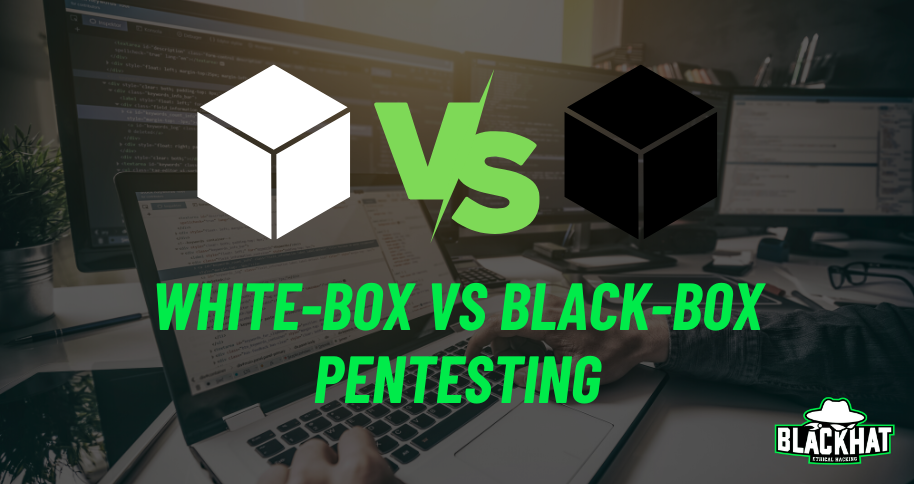The Difference between White-Box and Black-Box Pentesting

Reading Time: 3 Minutes
Introduction
Each Pentesting solution is different, with varying expertise and specialties. Before you decide who will perform it and which approach you will take, it’s important to have an idea of what you want out of a Pentesting.
For example, you’ll need to decide on the scope of work and what area of the infrastructure you want to assess, like your network, web applications, or different IoT devices. You also need to think about the project type, determining whether you’re looking for a more focused penetration test that will uncover and exploit weaknesses or a more comprehensive teaming exercise aimed at training a defense team by simulating an attack scenario.
Whether Internal or External, the approach certainly is important to study before proceeding in choosing the assessment. The way you discuss your scope in the initial stages and define the amount of info shared can be crucial. In the real world, an attacker will have zero knowledge and will still get access if he targets your company without any questions asked.
In this article, we will explain the difference between White-Box and Black-Box Penetration Testing.
When we speak of Black and White Boxes, we are speaking of the amount of access a pentester has been given before attempting to breach a system or network and the approach.
So, what are the differences between the White-Box and Black-Box Pentesting?
White-Box:
Also known as Clear Box testing or Glass Box testing, is a penetration testing approach that involves sharing full access network and system information with the testers. White-Box testing aims to identify potential weaknesses in various areas such as logical vulnerabilities, potential security exposures, security misconfigurations, poorly written development code, and lack-of-defensive measures.
The goal of a White-Box penetration test is to provide as much information as possible to the penetration tester so that he/she can gain an insightful understanding of the system and elaborate the test based on it specifically giving us in scope only things to check.
Having and sharing this information helps to save time and reduce the overall cost of an engagement. White Box testing is considered low-level testing.
The Pros of this type of testing are:
- Deep and thorough testing
- Maximizes testing time
- Extends the testing area dealing with critical issues
The Cons of this type of testing are:
- It makes assessments more difficult and limited in exploitation where the live impact is involved in the current state of systems in scope.
- Test cases are difficult to design due to environment-specific metrics, and finding vulnerabilities may take longer than other tests.
However, it is a non-realistic attack, as the penetration tester is not in the same position as a non-informed potential attacker. Also in the real world, hackers are not told what is in scope or how and when to attack. This is where Black-Box comes in.
Black-Box:
A Black-Box penetration test requires little or no information from the tester about the target system (applications or network) and usually takes the approach of an uninformed attacker. The pentester in this instance follows the approach of an unprivileged attacker, from initial access and execution through to exploitation.
This type of testing can be seen as the most authentic and realistic of a Cyber Attack, demonstrating how an adversary with no inside knowledge would target and compromise an organization. Just like in the real world.
However, it also requires a great deal of time and has the greatest potential to overlook a vulnerability that exists within the internal part of a network or application.
Black-Box testing is a powerful testing technique because it exercises the behavior of a system end-to-end.
The Pros of this type of attack are:
- Ability to approach your company by all means necessary. Unorthodox techniques are used that combine Social Engineering, manually look for outdated versions, and exploit them using custom code and tools to gain and elevate access.
- Post exploitation then goes through spending time inside your network performing and looking for information that could damage your company, including planting ransomware and escalating to a more critical impact.
The Cons of this type of attack are:
- It does not cover in-depth assessment as compared to white-box tests.
- It is performed against production environments in the case of an active directory, and internal LAN/networks.
See Also: Solutions: Web Application Pentesting
Which one is best for your Company?
A penetration test aims to identify potential vulnerabilities in your systems before criminal hackers do. When commissioning a penetration test, by Defining the concerns, you would like to resolve is essential to designing a customized approach that will effectively meet the necessary security requirements and result in the most value from your penetration testing investment. There is no right/wrong decision about White-Box or Black-Box. It depends on the scenario that needs to be tested and your requirements.
Our team of highly skilled and innovative ethical hackers at BHEH customizes every engagement to ensure the most thorough penetration test possible tailored to your needs. We understand that not every architecture or application fits into a predefined box and will require an adaptive testing methodology to develop a solution that works best for your organization.
There is no minimum threat in Cyber Security. An old saying about achieving high quality in manufacturing is “You can’t manage what you can’t measure.” From an Information Security standpoint, a better expression would be “You can’t protect what you can’t see.” Most importantly, you need visibility to where sensitive information is at all times.
After all, how would you know how you withstand a targeted attack if you do not test your equipment setups?
To find out more about how Black Hat Ethical Hacking can help you, check out our Solutions







